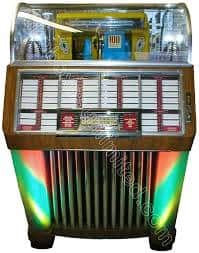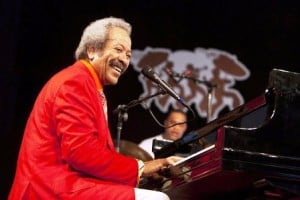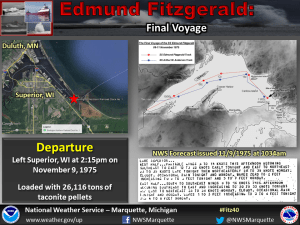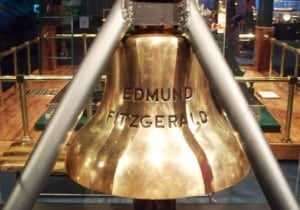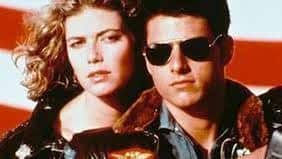Petula Clark’s historic television moment
On this date in 1968, “Petula”, airs on NBC. Petula Clark’s one and only TV special features guest star Harry Belafonte performing a duet of the British pop sensation’s antiwar song, “On The Path Of Glory.” During taping, Clark spontaneously reached and touched Belafonte’s arm. This brought a protest from the show’s sponsor, Chrysler Corporation, who feared that the act would upset southern viewers.
To ensure that the gesture would air, Petula and her executive producer husband, Claude Wolff, destroy all other takes of the duet. It becomes the first interracial contact to be broadcast on American television.
Another danger of decadent capitalism: The Twist
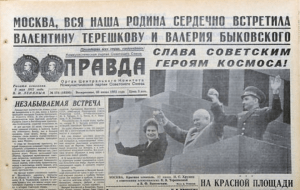 On this date in 1963, Russia’s official newspaper, Pravda, warns Soviet teens of the decadent dangers of the new “twist” dance craze. Chubby Checker’s biggest chart success was a worldwide sensation and was regularly heard behind the Iron Curtain on Radio Free Europe. Like most things your parents tell tell you not to do, the twist was most certainly practiced all across the Soviet bloc, further amplified by Checker’s follow up, “Let’s Twist Again, Like We Did Last Summer”. Dick Clark’s American Bandstand program, featured the former Ernest Evans performing his signature song. Here’s video of that special moment.
On this date in 1963, Russia’s official newspaper, Pravda, warns Soviet teens of the decadent dangers of the new “twist” dance craze. Chubby Checker’s biggest chart success was a worldwide sensation and was regularly heard behind the Iron Curtain on Radio Free Europe. Like most things your parents tell tell you not to do, the twist was most certainly practiced all across the Soviet bloc, further amplified by Checker’s follow up, “Let’s Twist Again, Like We Did Last Summer”. Dick Clark’s American Bandstand program, featured the former Ernest Evans performing his signature song. Here’s video of that special moment.
Look Homeward Angel – The Monarchs
This week in 1964, “Look Homeward Angel” by the Monarchs was at Number 1 on the WKNR Music Guide. The Monarchs formed in Louisville, Kentucky, in 1961. Their one national hit reached number 47 on the Billboard Hot 100, but as was so often the case back in the day when radio stations were locally programmed, their single caught on with Detroit audiences, supplanting the Beatles in the top spot on the survey. With a number of changes in personnel over the years, the band still performs today in the Louisville area.
Our Youtube link is notable for another feature, “Diane Sargent’s” custom record sticker, popular during the WKNR era as a way of making sure that the records you may have taken to a local sock hop came home with you.
https://www.youtube.com/watch?v=HGshk3P4Osc
Keenerland Updates
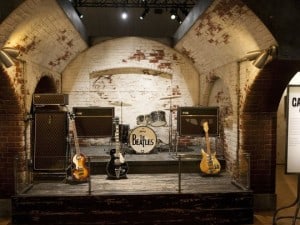 The Freep is reporting that a new Beatles exhibition is headed to Keenerland. “”The Magical History Tour: A Beatles Memorabilia Exhibition,” will run April 30-Sept. 18 at the Henry Ford Museum, “featuring artifacts and galleries tracing the Beatles’ trajectory from the band’s Liverpool origins up through the post-breakup days… Visitors can tour a mock-up of Liverpool’s Cavern Club and make custom mixes of tracks recorded at Abbey Road Studios.”
The Freep is reporting that a new Beatles exhibition is headed to Keenerland. “”The Magical History Tour: A Beatles Memorabilia Exhibition,” will run April 30-Sept. 18 at the Henry Ford Museum, “featuring artifacts and galleries tracing the Beatles’ trajectory from the band’s Liverpool origins up through the post-breakup days… Visitors can tour a mock-up of Liverpool’s Cavern Club and make custom mixes of tracks recorded at Abbey Road Studios.”
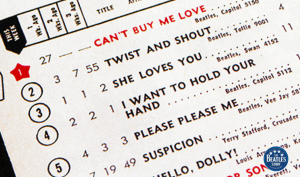 Speaking of the Fab Four, it was April 4th, 1964 that the band held down the top 4 spots on the Billboard Hot 100. In order from number one, “Can’t Buy Me Love”, “Twist and Shout”, “She Loves You”, “I Want to Hold Your Hand” and “Please Please Me.” Keener was ahead of the Beatle curve that week. The Top 5 on the WKNR Music Guide included were:
Speaking of the Fab Four, it was April 4th, 1964 that the band held down the top 4 spots on the Billboard Hot 100. In order from number one, “Can’t Buy Me Love”, “Twist and Shout”, “She Loves You”, “I Want to Hold Your Hand” and “Please Please Me.” Keener was ahead of the Beatle curve that week. The Top 5 on the WKNR Music Guide included were:
1. Look Homeward Angel – The Monarchs
2. Can’t Buy Me Love – The Beatles
3. New Girl in School/Dead Man’s Curve – Jan & Dean
4. Do You Want to Know a Secret – The Beatles
5. Shangri La – Vic Dana / Robert Maxwell
 Happy 81st birthday to Herb Alpert. The erstwhile trumpeter and record executive was co-founder of A&M records, discovering the West Coast band We Five, Chris Montez, The Carpenters, Sérgio Mendes and Brasil ’66 and others. His band, The Tijuana Brass, had hits with “The Lonely Bull”, “A Taste of Honey”, “What Now My Love”, “Spanish Flea” and the theme from the film “Casino Royale”, plus a solo turn with “This Guy’s In Love With You” in 1968. Alpert had five No. 1 albums and earned nine Grammy Awards. Fourteen of his LPs went platinum, fifteen earned gold record status.
Happy 81st birthday to Herb Alpert. The erstwhile trumpeter and record executive was co-founder of A&M records, discovering the West Coast band We Five, Chris Montez, The Carpenters, Sérgio Mendes and Brasil ’66 and others. His band, The Tijuana Brass, had hits with “The Lonely Bull”, “A Taste of Honey”, “What Now My Love”, “Spanish Flea” and the theme from the film “Casino Royale”, plus a solo turn with “This Guy’s In Love With You” in 1968. Alpert had five No. 1 albums and earned nine Grammy Awards. Fourteen of his LPs went platinum, fifteen earned gold record status.
 And speaking of birthdays, it’s either “Happy 92nd,” or “Happy 94th” birthday to singer / actress, Doris Day. Depending on who reports it, she was born on April 3rd, 1922 or 1924. Born Doris Mary Ann Kappelhoff, she began her career as a big band singer, hitting with “Sentimental Journey” in 1945. She was soon signed to Columbia Records, turning out over 650 recordings between 1947 and 1967. Wikipedia records her first film appearance in 1948 co-starring in “Romance on the High Seas”, launching a Hollywood career that continued well into the 1960s. She was paired with the industry’s most bankable leading men. Here are just a few: Clark Gable in Teacher’s Pet (1958), Rock Hudson in Pillow Talk (1959), Lover Come Back (1961) and Send Me No Flowers (1964), Cary Grant in That Touch of Mink (1962), and James Garner in The Thrill of It All and Move Over, Darling (1963). Day was ranked the biggest box-office star, the only woman appearing on that list in the era, for four years (1960, 1962, 1963 and 1964). She was married four times. Her only son, Terry Melcher had a hit on Keener when he partnered with future Beach Boy, Bruce Johnston to record “Hey Little Cobra” as The Rip Chords. Melcher was best known as a producer for The Byrds, Paul Revere and the Raiders and the Beach Boys before his death from melanoma at the age of 62.
And speaking of birthdays, it’s either “Happy 92nd,” or “Happy 94th” birthday to singer / actress, Doris Day. Depending on who reports it, she was born on April 3rd, 1922 or 1924. Born Doris Mary Ann Kappelhoff, she began her career as a big band singer, hitting with “Sentimental Journey” in 1945. She was soon signed to Columbia Records, turning out over 650 recordings between 1947 and 1967. Wikipedia records her first film appearance in 1948 co-starring in “Romance on the High Seas”, launching a Hollywood career that continued well into the 1960s. She was paired with the industry’s most bankable leading men. Here are just a few: Clark Gable in Teacher’s Pet (1958), Rock Hudson in Pillow Talk (1959), Lover Come Back (1961) and Send Me No Flowers (1964), Cary Grant in That Touch of Mink (1962), and James Garner in The Thrill of It All and Move Over, Darling (1963). Day was ranked the biggest box-office star, the only woman appearing on that list in the era, for four years (1960, 1962, 1963 and 1964). She was married four times. Her only son, Terry Melcher had a hit on Keener when he partnered with future Beach Boy, Bruce Johnston to record “Hey Little Cobra” as The Rip Chords. Melcher was best known as a producer for The Byrds, Paul Revere and the Raiders and the Beach Boys before his death from melanoma at the age of 62.
Happy Birthday to the Jukebox
November 23, 1899, the world’s first jukebox was installed at San Francisco’s’ Palais Royal Hotel.
My favorite jukebox, at the original Mr. Joe’s on Northwestern Highway in Southfield, was loaded with rock, pop, country, and American Songbook classics. And for a number of years in the early 70’s, and especially during the holidays, we would inevitably gather at Mr. Joe’s, for stories, both true and false, cold beers, burgers and laughs.
Equally inevitable was one of us deciding it was time for our favorite song.
I think it was #116. Based on the amount of quarters we fed Mr. Joe’s jukebox, it should have been Number One!
Sunday Brunch With Ray Charles
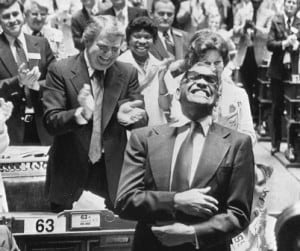
By Bob Berry
This weekend marks a major anniversary for one of the most beautiful songs in the Great American Songbook.
It was November 14th, 1960 when Ray Charles’ version of Hoagy Carmichael (music) and Stuart Gorrell’s (lyrics) “Georgia On My Mind” hit Number One.
Written in 1930, the song had long since become a standard, but it took the genius-and the soul, of a native son, the son of a sharecropper, to reveal the wistful beauty of an American classic.
There was another big day associated with Ray Charles and “Georgia On My Mind”, March 7, 1979.
That was the day that same son of a sharecropper, a blind black man who had walked with kings, was invited to sing a song he had made his own on the floor of the Georgia General Assembly.
It was the day “Georgia My My Mind” became the official state song of the state of Georgia.
Enjoy Sunday Brunch on Keener.
A Friday Song Double Shot
I’m “..not too proud to shout it, tell the world about it..”, “This Old Heart of Mine” is one of the Motown copyrights I truly love.
Written by Holland-Dozier-Holland, with Sylvia Moy ( co-writer of Uptight, I Was Made To Love Her, It Takes Two and others), there’s just something about that song.
The original version, by The Isley Brothers, had me cranking up Keener while driving down 13 Mile Road. Two and a half decades later, driving around West Michigan, the car radio was just as loud for Rod Stewart’s “This Old Heart”!
But for the life of me, I can’t tell you which is my favorite. Thus a Keener Friday Song “Double Shot”.
Released in the January of 1966, “This Old Heart Of Mine” gave The Isleys their only major hit for Motown, going straight to the Top Ten. Give another listen to a stellar lead vocal by Ronnie Isley, backed by one of the classic tracks of The Funk Brothers (and the DSO strings!)
Some 23 years later, Rod Stewart released his second version (a previous single in ’75 got minor airplay) of “This Old Heart”, and this time he brought in the big gun, Ronnie Isley! The R&R duet, produced by Bernard Edwards of Chic and Trevor Horn (Yes, The Buggles), went Top Ten in the summer of 1989, and proved that Ronnie Isley had lost nothing ‘off his fastball”.
#TBT With Donna Summer
It’s an astounding song, really.
Lyrics, “…someone left a cake out out in the rain…” that are at once allusive and elusive. A song-poetry, really, built in 4 sections, or movements, much like a classical composition. And, it was 7 minutes long in it’s original form.
And yet, Jimmy Webb’s “MacArthur Park”, for all it’s contrarian Top 40 radio characteristics, has twice been a smash.
The original, the debut recording for Irish actor Richard Harris was Top 5 in the summer of ’68. And, again ten years later, for Rock and Roll Hall of Fame member, Donna Summer.
At the height of her success, her 4 minute single was Number One for the week of November 12, 1978, on both the Billboard Hot 100 and Dance charts. And, at the same time, she was #1 on the albums charts, with her album Live and More, featuring the eighteen minute “MacArthur Park Suite“.
Enjoy Throwback Thursday on Keener!
NOLA Music Legend Allen Toussaint Dies At 77
You can hardly feel sadness when person dies doing what they truly loved. And so it is with the news of Allen Toussaint’s death in Spain on Monday.
Mr. Toussaint, a member of the Rock and Roll Hall of Fame, was 77.
His career in music was legendary, and in a city of musical giants, Louis Armstrong, Professor Longhair, Fat Domino, Dave Bartholmew and the Neville Bros., to name a few; Mr. Toussaint career and contributions stand second to none.
We at Keener13.com mourn the passing of Allen Toussaint, and celebrate his life with a Top 5 overview of his music. Rest In Peace, knowing we are forever grateful for the good times you have left for the ages.
In 1975, be it at the roller rink, the dance floor, house party on on the radio, you could not miss the unmistakable sound of Patti Labelle, with a #1 song written by Bob Crewe and Kenny Nolan, and produced by Mr. Toussaint.
Number One in 1961, written and produced my Allen Toussaint, here’s Ernie K-Doe.
Inspired by his childhood memories of nights in Louisiana, Mr. Toussaint’s “Southern Nights” resonated with Glen Campbell, who hit # 1 on three different charts in 1977.
Another smash from The Big Easy, Lee Dorsey was Top 10 in 1966, with another song written and produced by Allen Toussaint.
https://www.youtube.com/watch?v=IsZT-Gj7QNI
And, you save (one of) the best of the best for last. This one we remember (more) from driving with our Dads, listening to “their” stations. NOLA jazz great Al Hirt, with a Top 5 song written by Mr. Toussaint (and produced by the great Chet Atkins), from 1964.
Keener Remembers The Twenty Nine
“The legend lives on from the Chippewa on down of the big lake they call Gitchee Gumee..”
Nearly every member of the Keener Generation can vividly recall the opening of Gordon Lightfoot’s most successful recording, a cautionary tale about the awesome power of Mother Nature and the fate that befell the 29 men who were caught in her turbulent grasp 40 years ago today.
They were fathers, brothers, husbands, by all accounts, good men, tough and hard-working men, who sailed the Great Lakes on an ore-carrier.
Edward Sherman, then a young man in Door County, Wisconsin, remembered the weather that day. “It was a lot like the hurricanes that I later experienced in Florida.” The storm would become one of the worst to be recorded in the history of Lake Superior, sending what was then the biggest ever vessel that traversed her to the bottom.
It’s been 4 decades since the S. S. Edmund Fitzgerald slipped beneath the churning waves. It happened shortly after 7:10pm, near Superior’s southernmost point, only a few miles away from the safety of Whitefish Bay.
She was the pride of the shipbuilders at the Great Lakes Engineering Works in River Rouge when she was christened in 1958. Chris Gillcrist, Executive Director of the National Museum of the Great Lakes, told Toledo, Ohio’s abc13, “They built bigger boats after her but she continued to break seasonal tonage records because she ran long and she carried a lot. She started work early in the season and she was never laid up.”
The sheer size of the Edmund Fitzgerald made her a tourist attraction. “I can still picture it sitting here being overwhelmed by its size,” remembers former Toledo Blade editor, Tom Walton. “It was longer, bigger and faster than any other ship out there.”
Her ultimate destination was the Detroit Ironworks on Zug Island, near Ford’s mammoth River Rouge complex. Her cargoes were forged into automobiles, construction material and the sturdy iron skeletons of enduring edifices that could stand tall against the worst of Superior’s legendary squalls.
But on that November night, as “the ship’s bell rang.” nothing could protect The Edmund Fitzgerald from her inexorable fate.
The weather forecasts that day predicted 10 foot waves and winds peaking at a manageable 36 knots. But then, as now, divining the behavior of the swirling pressure systems that spawn “the gales of November” was was in inexact science. Captain Ernest McSorley had no reason to believe the trip would be any different from the dozens of November runs he had made during his career.
As the morning of November 10th dawned, the weather service upgraded the forecast, the Soo Locks were closed and ships on the big lake were encouraged to seek shelter.
The storm had shut down the navigational aids at Whitefish Bay. The powerful winds, the worst that Captain McSorley had ever experienced, disabled both of the Edmund Fitzgerald’s radar systems, torw a railing from it’s moorings and destroyed two crucial vent covers. The heavy seas flowing over her decks made it impossible for the ships 6 bilge pumps to keep ahead of the water that was pouring in.
Throughout the storm, Captain McSorley had been in contact with another vessel, the Arthur M. Anderson. It’s skipper, Bernie Cooper, made the last radio contact with McSorley. With wind gusts now raging near 80 knots, the doomed Captain reported, “We are holding our own.”
Just minutes later, the great ship disappeared from the Anderson’s radar screens. No distress signal was ever received.
One year later, Captain McSorley’s step daughter was driving through Toledo, Ohio, when she heard Gordon Lightfoot’s classic composition for the first time. “I had to pull off the road,” Nancy Ulrich told the Toledo Blade. “I was so overcome with emotion. I think it’s beautiful, a tribute to dad, to all the men on the ship and to their families.” Soon thereafter, a package appeared on Ms. Ulrich’s front porch. It was a copy of the album, with a personal message from Lightfoot himself.
May the souls of the 29 Rest In Peace, honored by a generation’s love for the artistry of a Canadian folksinger and forever a part of the eternal splendor of the Great Lakes.
Read more coverage of the story in The Detroit News and The Detroit Free Press. Visit the memorial Facebook Page. And learn more about the song here.
Kickin’ It With Crockett & Tubbs
Miami Vice changed a lot of things.
Changed the perception of Miami and South Beach, which truth be told was a dump when the show went on the air.
Changed the perception of how detectives dress, and the cars they drive. Made Don Johnson and Phillip Michael Thomas the hottest stars on TV. And it made their characters, Crockett and Tubbs, the coolest TV detectives ever, and a convenient costume idea for men of all ages
Changed the lives and gave a number of actors their big break, including Chris Rock, Liam Neeson andJulia Roberts. Plus Royal Oak’s Glenn Frey whose role in Season One’s “Smuggler’s Blues” (and the episode title song he wrote) was one of the shows that sealed the deal for the series.
Miami Vice married the idea music videos as integral to TV story-telling, most notably on Phil Collin’s “In The Air Tonight“, and made Jan Hammer a household, well, if not word, a known reference. The Czechoslovakian composer was the genius behind “Crockett’s Theme“, and the two-time Grammy Award winning “Theme From Miami Vice“.
It was Number One, 30 years ago today, November 9th, 1985.
Sunday Brunch with Berlin And Top Gun
November 8, 1986. Can it really be 29 years ago?
Berlin’s mega-hit from the great Top Gun soundtrack, “Take My Breath Away” went to Number One for the first of four weeks.
Sure, the song was helped by a terrific script, co-written by Michigan State professor and good friend, the late Jim Cash and his writing partner Jack Epps Jr. And yeah, there was great casting. Kelly McGillis buttoned-up smart blonde, until she kicked in the afterburners. Tom Cruise showing off his now all-too-familiar (see picture at left) sullen intensity.
But, man. When this song kicked in, and the sparks flew, you knew from note one that “Take My Breath Away” was a smash.
And, all credit to the filmmakers. They didn’t use the song for the volleyball scene!
Enjoy Sunday Brunch on Keener. Careful for the afterburners!

